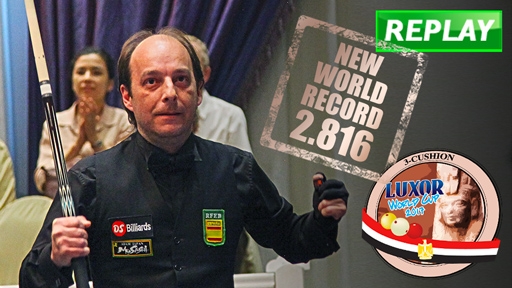Equal innings, what's the point?
September 6, 2014 at 8:35am
By Bert van Manen
There was a bright, pool-playing youngster on English Kozoom chat the other day, watching 3-cushion with appreciation. He was critical of the equalizing inning. With typical 20-year old overconfidence, he said: “Completely idiotic system, if you are the first to cross the finish line, you win. Who wants a draw in sports anyway? Why even play the lag, if there is no advantage in winning it?” Let me say it again, it was a smart kid. But his comments proved he was clueless about the psychology of billiards. An equal-innings match is a thing of beauty. If you’ve played a thousand of ‘em, you know.
Forget about sets for a moment, whether best of three or best of five. Of course there is no equalizing inning there, and of course there is an advantage when you win the lag. That’s all pretty obvious. But what about matches to 40 or 50? This is my opening question: if every (every!) top class player in the world elects to start the match, does that not suggest to you, Mr. 20-year old, that you are better off with the white chess pieces than with the black ones, even if they are identical? The key word here, is initiative. You want to score a few points from the break, three at least, and you also want to make sure your opponent starts the match with a much more difficult position than the one you got. If all goes to plan, you can control the game for a while, build up a useful lead in the first 4 or 5 innings, and get the other guy on the back foot. Maybe you will have found your natural rhythm and stroke before he even has 3 points on the board. It’s as if the rules of the game give you a weight and reach advantage in a boxing match, and you should capitalize on it. You want to get the first punch in, and you want it to hurt.
Did you earn that lovely, dominant position you are in? Yes. You won the lag.
So you are – more often than not - in the driving seat early in the game. But if you can’t get rid of the other guy, HE IS, in the latter stages. If you are playing to 40 and it’s 37-37, you are in more danger than he is. Any mistake you make can be your last. If he runs 3, it’s over. If you do, he still has an escape hatch, a back-up plan. You are the one under pressure now, the weight and reach advantage has shifted to your opponent. You have to be ultra careful: only a point made or perfect defense will be good enough. He can be aggressive, go for the shots.
Did he earn that position he is now in? Yes. You had the advantage, but he still got back to 37-37.
And then there is that cruel, exciting phenomenon we call a “shootout”, or “penalties” as it’s incorrectly but commonly called in Europe. High drama, audiences absolutely love it. I’ve played my fair share of shoot-outs in the past 25 years or so, and I can tell you: if that does not get your blood racing, nothing will. It is a wonderful test of will and nerve and character. Billiard players only have a few seconds to adjust to the fact that their heart rate is up to 185 and their cue suddenly weighs more than a Ford Explorer. You get to know yourself in those moments, you learn, you hurt, you grow. And this is the absolute beauty of it: you come out a wiser person, whether you have failed or passed the test. Whatever we do with our formats, let’s never get rid of the shoot-out.
In my opinion, there is nothing wrong with the equalizing inning, if applied to 40 or 50 pt matches. It’s very fair to both players, but still leaves the importance of the lag intact. And by the way, 20-somethings of the billiard world: you are not going to solve every problem our sport has by shortening distances and increasing the luck factor. Three cushion formats, whatever we decide they should be, must always favor the strongest players. Call me a dinosaur, I don’t care. Billiards is one of the noblest of sports, 3-cushion is its King’s discipline. Let’s never turn it into a glorified roll of the dice.
